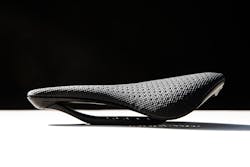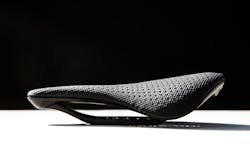Carbon partners with bicycle equipment makers to 3-D print seats
Carbon and Specialized Bicycle Components on Aug. 27 announced a partnership to produce its first 3-D printed bike saddle, the S-Works Power Saddle with Mirror Technology. Days later, Carbon unveiled a similar deal with Fizik, a manufacturer of bike saddles, shoes and accessories.
Bike manufacturer Specialized had used 3-D printing to make saddle prototypes, and the company decided the evolution of the technology and new resins with better properties would allow for series production of saddles that could provide greater comfort.
“Carbon has a lattice-generating tool,” said Garrett Getter, product manager of saddles, grips and tapes for Specialized. “In combination with their design engineering team and our design engineering team, we set out to address a unique problem that … riders face. The saddle, by definition, is something that humans aren’t anatomically designed to sit on.”
The company continually strives to develop seats that are more comfortable and allow riders to ride longer. However, traditional foam padding has limitations. With its unique lattice structure, the new S-Works Power Saddle with Mirror technology helps dissipate the pressure on a rider’s sit bones, he said. It has no foam padding.
Using the lattice-generating tool and Carbon’s printers, the two companies were able to create specific areas of varying firmness in an effort “to create a saddle that was more comfortable than any traditional foam saddle that is on the market to date,” Getter said.
The new saddle absorbs impact and improves stability, which can reduce the chance of rider injury, according to the companies.
The entire top of the saddle, including the cover, is 3-D printed and formed on top of a carbon-
fiber shell.
To make the saddle, a Carbon L1 3-D printer uses Carbon’s Digital Light Synthesis (DLS) technology, which projects ultraviolet light through an oxygen-permeable window onto a bath of UV-
sensitive liquid resin. That resin then forms into parts with excellent mechanical properties, resolution and surface finishes, the company said. The printing process takes about 30 minutes; curing takes a little longer. After the saddle is printed, a spinner removes excess resin, and an excimer lamp cures the plastic and creates the saddle’s matte finish and grip. A convection oven then bakes the saddles.
Parts printed with DLS technology are similar to injection molded parts. DLS creates parts that are solid on the inside, and produces consistent and predictable mechanical properties, the company said. Parts made by other 3-D printing processes often exhibit variable properties, because, depending on the process, the resins are laid out with a particular orientation, causing them to be stronger in one direction than another. In contrast, DLS parts exhibit consistent characteristics throughout. Carbon’s DLS technology also produces parts with a surface finish that requires no polishing or surface treatments other than the post-printing spinning process and washing.
“That enables us to have isotropic mechanical properties, and also final-finish parts,” said Erika Berg, head of application development at Carbon. “The surface finish looks very smooth, and it’s very different from traditional additive manufacturing,”
In designing the saddle, the companies used Carbon’s technology and Specialized’s pressure mapping techniques to mitigate sit-bone pressure and related injuries. The saddle is printed using Carbon’s EPU 41 resin, an elastomeric PU that provides cushioning, impact absorption and vibration isolation.
The seats will be available in two widths: 143mm and 155mm. The narrower version weighs 189 grams.
In addition to being able to make a more comfortable saddle, the companies benefited from another advantage of 3-D printing: faster iterations.
Carbon’s technology reduced the product development process from the typical 18 to 24 months to just 10 months; in that time, the companies created and tested more than 70 designs. The design process was reduced from six to two months, with each iteration, which typically takes two to three weeks, taking only one day.
One of the factors that has allowed Specialized and Carbon to develop the S-Works Power Saddle with Mirror Technology so quickly is Carbon’s software, Berg said.
“The last aspect that is really unique to our process is our software,” she said. “The Carbon Lattice Engine is an FEA, finite element analysis, cloud-based tool that we’ve created. It’s unique because we’re able to take customers’ design space inputs and their desired response, and we’re able to create variable-density lattices and do thousands of simulations before we’re even creating the first part. That’s what’s really enabled all of these launches to move significantly faster or the key thing that enabled them to move faster.”
The software can quickly run through algorithms and change features like the thickness of a strut in the lattice or the space between each strut and then calculate the effect of each change on rider comfort.
“It’ll manipulate every one of those little things to get to exactly the response that you want, whether it’s a softer or stiffer response,” Berg said. “Then, the tool also checks for printability.”
The software can carry out these complex calculations much faster than any human could, she said.
With the new saddle set to hit the market next year, Specialized is looking at other possible partnerships with Carbon, Getter said.
“We do a lot of products for the rider, such as clothing, shoes, helmets; we do the grips that you use, all the touch points on the bicycle,” Getter said. “And, yeah, we definitely see the utilization of 3-D printed technology as a way to continue to push the envelope in design, to try to make our riders more comfortable and able to perform at their best.”
FIZIK AND CARBON
Carbon also has a partnership with Fizik, an Italian manufacturer of high-performance bicycle saddles. It is making Fizik’s first 3-D printed bike saddle, the Adaptive, which will be available in the coming months.
The companies use L1 printers to produce a saddle with excellent mechanical properties, resolution and surface finish, the companies said.
The new saddles, which feature a lattice design, match cyclists’ needs in terms of power transfer, shock absorption, stability and comfort, with none of the constraints imposed by traditional production methods or materials such as foam, the companies said.
Fizik designed the Adaptive saddles using pressure-mapping data it collected over nine years from professional cyclists.
In the future, Fizik hopes to customize saddles for each rider. It would collect a customer’s pressure-mapping data in one of its stores and create a personalized saddle.
Bruce Geiselman, senior reporter
Carbon, Redwood City, Calif., 650-285-6307, www.carbon3d.com
About the Author
Bruce Geiselman
Senior Staff Reporter Bruce Geiselman covers extrusion, blow molding, additive manufacturing, automation and end markets including automotive and packaging. He also writes features, including In Other Words and Problem Solved, for Plastics Machinery & Manufacturing, Plastics Recycling and The Journal of Blow Molding. He has extensive experience in daily and magazine journalism.

